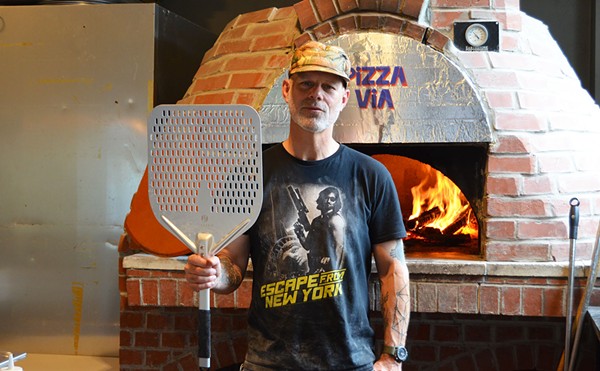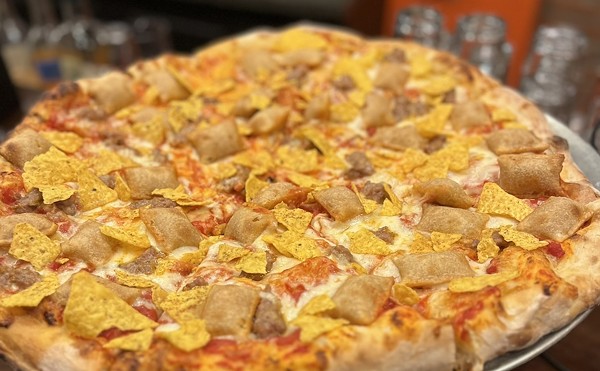In 2000, less than a month after the hit show opened at the Fox Theatre, husband and wife Si and Nga Vo took over Mai's Garden, changing the name to Miss Saigon but keeping much of the old menu. Four months ago, after a successful four-year run at their dowdy Kenrick Plaza location, the Vos moved the restaurant to the corner of Delmar Boulevard and Rosedale Avenue. Here, amid the vibrant atmosphere of major entertainment venues and several new ethnic restaurants, the Vos are drawing more amblers intent on a night out than they ever did by sitting in a strip mall next to Shoe Carnival.
Miss Saigon's new space fits right into the general design theory of surrounding new restaurants: sleek, high-tech and exquisitely minimalist. The renovated storefront consists of a large, open dining room and bar in the front and a smaller, cozier smoking room in the back. Both rooms have an expansive view of Delmar and are cleanly decorated with a backdrop of yellow and mauve walls; metal-cylinder sconces; tall, slim flower vases; and large, simple paintings colored in light-green hues. Even the mirrored, dark-wood back bar looks spare, with a small array of neatly organized wine bottles and bottled beer (mixed drinks aren't available).
Nothing in the décor even whispers "Asian" -- no little Buddhas, no Chinese fans, no carved wooden chairs. With its high-gloss wood floors, high ceilings and contemporary metal chairs, Miss Saigon feels more like a cool loft apartment than a Vietnamese restaurant.
While there's nothing particularly groundbreaking about the food at Miss Saigon, it is good, basic Vietnamese fare -- the type of food I imagine the Vos cook when their families congregate. Chef Si's sister owns the popular Mai Lee, and Nga's sister is a partner in the equally popular Pho Grand. As with those other restaurants, the Vos focus on rice-noodle soups (pho), noodle bowls (bun), rice plates (com dia) and an assortment of beef (bo), chicken (ga) and shrimp (tom) dishes.
There are fourteen "house specialties," including ca kho to, a classic dish of catfish cut into bone-in steaks, which are then baked and served in a clay pot. Fish sauce, a Vietnamese staple, is tamed with lightly caramelized sugar and buttressed with spices and bits of caramelized pork. Fragrant plumes of sweet-salty-sour pungency fill the nostrils when the pot arrives at the table. It's a strong, delectable sauce, but one that's meant to be served over rice.
New York Times food writer Mark Bittman writes that "[M]uch has been made of the French influence on Vietnamese cooking, but Vietnamese cooking was terrific before the French colonized the country. For centuries, a huge variety of fresh herbs and greens made its cuisine distinctive." Such is the case with Vietnamese noodle bowls. Everything you need is right in one dish: a bed of hot vermicelli noodles topped with crunchy-cold shredded lettuce, cucumber, bean sprouts and, with my order, tasty marinated grilled pork and a segmented egg roll. All of this is topped with cilantro, chopped peanuts and a lemon-garlic sauce that soaks into the noodles. The freshness of this lively bowl awakens the palate, seducing you to take just one more bite. You can also get noodle bowls with beef, shredded pork, chicken or grilled shrimp.
Bo luc lac (beef chunks stir-fried with greens, tomato and onions) is a must-have around our house; we've sampled nearly every version in St. Louis. But what put Miss Saigon's in the top category were cubes of flank steak cooked medium-rare -- something that we didn't expect but certainly appreciated, as it's a nice change from the well-done variety usually found in the dish. The same flank steak, when sliced thin against the grain, isn't as rare but is still delectable when stir-fried with pineapple chunks, tomato, celery and onions in that lemon-garlic sauce that seems to show up a lot. Stir-frying shrimp, chicken, squid and crabstick with snow peas, bok choy, carrots and straw mushrooms produces mi xao gion, a large meal served in a light sauce fragrant with ginger and garlic. Characteristic of the ying-yang approach of Vietnamese cuisine, a foundation of crispy fried egg noodles adds another layer of texture and contrast to the dish.
Spring rolls (goi cuon) are an excellent way to assuage increasing hunger pangs while studying the menu, and Miss Saigon's are the best I've had: plentiful amounts of shrimp, pork, rice noodles and vegetables rolled in rice paper. Two pleasant surprises: the addition of mint leaves to the rolls and a peanut dipping sauce. On both visits these addictive cylinders were obviously freshly rolled, as were the summer rolls (bi cuon), which were equally delicious and plumped up with shredded pork, vegetables, shredded greens and served with a lemon-garlic sauce.
On the beer list there is, of course, Saigon beer from Vietnam and Tsingtao from China, but there's also French 33 beer, and no, it's not the French version of Rolling Rock. Most people drinking wine with Vietnamese food choose white rather than red, probably because the tannins in red wine clash loudly on the tongue when mixed with the sweet-sour notes of the sauces. There's a handful of inexpensive wines available by the glass and bottle (around $5 per glass; $16 to $24 per bottle). Of the three white wines, two Rieslings (Alsatian and German) and a pinot grigio, the Rieslings make suitable partners for Asian cuisine, balancing sweetness and acidity to complement the range of flavors.
Those preferring nonalcoholic beverages can wash down their meals with fresh-squeezed, ice-cold lemonade, which is prepared with hot water to melt the extra sugar for a slightly more syrupy and concentrated beverage. There's also Vietnamese coffee, the habit-forming mixture of strong chicory coffee and sweetened condensed milk served over ice that is often the only sweet ending I need. Other desserts in a glass, though, include three smoothies (jackfruit, strawberry and pineapple).
On a stretch of Delmar that seems to have a monopoly on Thai and Chinese eateries, Miss Saigon (along with the existing Saigon Café and the soon-to-be-open Modai sushi lounge) rounds out the full Asian dining experience.





